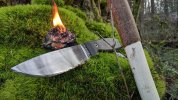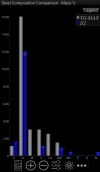- Joined
- Apr 15, 2012
- Messages
- 1,104
Two parts to this reply.
PART-1
Two questions:
1) Do you begin sharpening by destressing the edge, making apex flat removing all previously sharpened (worked aka fatigued) steel)?
2) During your grit progression are you using edge-leading or edge-trailing at each stage, and do you change based on where you are in the progression)?
I have personally had a few blades where an obtuse geometry (20-25dps) was weak, where a more acute geometry (15dps) later performed well on same knife in same applications. I attributed this to what we learned during the Elmax debacle from a few years back (fatigued apex steel weakness related factory grind effecting the temper of the edge metal). Last knife specifically was an ESEE-4 where the factory secondaries (>20dps) exhibited signs of chipping, taken to 15dps still exhibited chipping, destressed entire edge then taken to 15dps (removed fair amount of steel) and edge has held well since and became a daily carry. I had almost started to believe much of the internet that was talking (1.5 - 2 years ago) about weak edges on ESEE steel even though I owned a number of other ESEE with no such issue (I am glad I did not believe what others were saying ;-)
Knife specific example from my commentary with a little hot chaga on a cool moss bed:

From what I have seen and read in this thread, initial thoughts related to OP issue are as others have commented (Twindog, Obsessed with Edges, 3D Anvil
, Stockman) possibly related to stressed apex steel), or maybe something like PART-2 below ...
3D Anvil
, Stockman) possibly related to stressed apex steel), or maybe something like PART-2 below ...
PART-2
However, when I re-review the OP images and look specifically at last image of OP initial Post#1, appears to show what appears to be voids in the steel behind the apex (Quote: Post#1 " it looks like there are "holes" all along my edge."). That last photo sheds similar light on the additional photos in the OP. I have experienced similar condition on a knife a few years ago that had a VG-MAX blade core. In this steel I witnessed and experienced voids or inclusions in the blade steel that were superficially small, but opened up larger in the grinding process. I will post a link to thread and photos where I discussed this.
Here is a copy/paste from the thread mentioned above describing condition/experience:
Moving through the other knives I keep getting the sense that I am chasing chipping. Chipping that was gone or not existent appears. Initially the 3.5" Pairing had huge chips in belly and few smaller chips nearing the ricasso all of a sudden now has a chip in the forward belly close to the tip (appearing right as I finished a short light series of finishing strokes). Inspection under magnification shows the edge apex was more or less intact, but there was a hole between the edge and the transition of the small secondary to primary bevel. OMG / WTF am I seeing. Additionally, it appears there is also a faint steel pattern difference in this area (faintly captured in the photos if you look closely). Hmmm , ... blade steel inclusion???
Two photo-composites below of DM0700 3.5-Pairing (before & after):
DM0700 3.5-Pairing Composite-1.jpg
Link: https://www.dropbox.com/s/bhz3f36aegkf3v0/DM0700 3.5-Pairing Composite-1.jpg?dl=0

Above Photo: (3 photo composite same knife, black sharpie marks inclusions, 3rd photo shows edge was intact below inclusion)
Link to thread mentioned: (Dropbox photo links from thread still active)
Shun VG-MAX Blade-Steel Inclusions ??
EDIT:
Blade Steel Composition Comparison:

If you want to discuss PART-2, please read through the linked thread and view the images related to the situ of that thread for explanations related to the photos and the experience ;-)
PART-1
Two questions:
1) Do you begin sharpening by destressing the edge, making apex flat removing all previously sharpened (worked aka fatigued) steel)?
2) During your grit progression are you using edge-leading or edge-trailing at each stage, and do you change based on where you are in the progression)?
I have personally had a few blades where an obtuse geometry (20-25dps) was weak, where a more acute geometry (15dps) later performed well on same knife in same applications. I attributed this to what we learned during the Elmax debacle from a few years back (fatigued apex steel weakness related factory grind effecting the temper of the edge metal). Last knife specifically was an ESEE-4 where the factory secondaries (>20dps) exhibited signs of chipping, taken to 15dps still exhibited chipping, destressed entire edge then taken to 15dps (removed fair amount of steel) and edge has held well since and became a daily carry. I had almost started to believe much of the internet that was talking (1.5 - 2 years ago) about weak edges on ESEE steel even though I owned a number of other ESEE with no such issue (I am glad I did not believe what others were saying ;-)
Knife specific example from my commentary with a little hot chaga on a cool moss bed:

From what I have seen and read in this thread, initial thoughts related to OP issue are as others have commented (Twindog, Obsessed with Edges,
PART-2
However, when I re-review the OP images and look specifically at last image of OP initial Post#1, appears to show what appears to be voids in the steel behind the apex (Quote: Post#1 " it looks like there are "holes" all along my edge."). That last photo sheds similar light on the additional photos in the OP. I have experienced similar condition on a knife a few years ago that had a VG-MAX blade core. In this steel I witnessed and experienced voids or inclusions in the blade steel that were superficially small, but opened up larger in the grinding process. I will post a link to thread and photos where I discussed this.
Here is a copy/paste from the thread mentioned above describing condition/experience:
Moving through the other knives I keep getting the sense that I am chasing chipping. Chipping that was gone or not existent appears. Initially the 3.5" Pairing had huge chips in belly and few smaller chips nearing the ricasso all of a sudden now has a chip in the forward belly close to the tip (appearing right as I finished a short light series of finishing strokes). Inspection under magnification shows the edge apex was more or less intact, but there was a hole between the edge and the transition of the small secondary to primary bevel. OMG / WTF am I seeing. Additionally, it appears there is also a faint steel pattern difference in this area (faintly captured in the photos if you look closely). Hmmm , ... blade steel inclusion???
Two photo-composites below of DM0700 3.5-Pairing (before & after):
DM0700 3.5-Pairing Composite-1.jpg
Link: https://www.dropbox.com/s/bhz3f36aegkf3v0/DM0700 3.5-Pairing Composite-1.jpg?dl=0

Above Photo: (3 photo composite same knife, black sharpie marks inclusions, 3rd photo shows edge was intact below inclusion)
Link to thread mentioned: (Dropbox photo links from thread still active)
Shun VG-MAX Blade-Steel Inclusions ??
EDIT:
Blade Steel Composition Comparison:

If you want to discuss PART-2, please read through the linked thread and view the images related to the situ of that thread for explanations related to the photos and the experience ;-)
Last edited:
